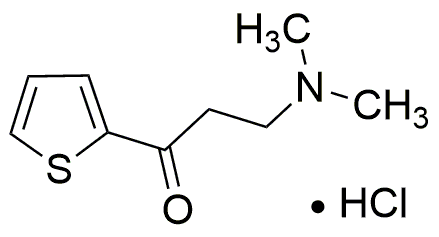3-(Dimethylamino)-1-(2-thienyl)-1-propanone hydrochloride is widely utilized in research focused on:
- Pharmaceutical Development: This compound serves as a key intermediate in synthesizing various pharmaceuticals, particularly those targeting neurological disorders, enhancing the development of effective treatments.
- Analytical Chemistry: It is used as a standard in analytical methods, helping researchers accurately quantify other compounds in complex mixtures, which is crucial for quality control in drug manufacturing.
- Material Science: The compound is explored for its potential in creating novel materials, such as polymers and coatings, that exhibit unique electrical or optical properties, beneficial in electronics.
- Biochemical Research: It plays a role in studying enzyme interactions and metabolic pathways, providing insights that can lead to breakthroughs in understanding biological processes.
- Cosmetic Formulations: The compound is investigated for its potential use in cosmetic products, particularly for its stabilizing properties, which can enhance product efficacy and shelf life.
Informations générales
Propriétés
Sécurité et réglementation
Applications
3-(Dimethylamino)-1-(2-thienyl)-1-propanone hydrochloride is widely utilized in research focused on:
- Pharmaceutical Development: This compound serves as a key intermediate in synthesizing various pharmaceuticals, particularly those targeting neurological disorders, enhancing the development of effective treatments.
- Analytical Chemistry: It is used as a standard in analytical methods, helping researchers accurately quantify other compounds in complex mixtures, which is crucial for quality control in drug manufacturing.
- Material Science: The compound is explored for its potential in creating novel materials, such as polymers and coatings, that exhibit unique electrical or optical properties, beneficial in electronics.
- Biochemical Research: It plays a role in studying enzyme interactions and metabolic pathways, providing insights that can lead to breakthroughs in understanding biological processes.
- Cosmetic Formulations: The compound is investigated for its potential use in cosmetic products, particularly for its stabilizing properties, which can enhance product efficacy and shelf life.
Documents
Fiches de données de sécurité (FDS)
La FDS fournit des informations de sécurité complètes sur la manipulation, le stockage et l’élimination du produit.
Spécifications du produit (PS)
Le PS fournit une description complète des propriétés du produit, notamment sa composition chimique, son état physique, sa pureté et les exigences de stockage. Il détaille également les plages de qualité acceptables et les applications prévues du produit.
Certificats d'analyse (COA)
Recherchez des certificats d'analyse (COA) en saisissant le numéro de lot du produit. Les numéros de lot et de lot se trouvent sur l'étiquette d'un produit, après les mots « Lot » ou « Lot de fabrication ».
Numéro de catalogue
Numéro de lot/série
Certificats d'origine (COO)
Ce certificat d'exploitation confirme le pays dans lequel le produit a été fabriqué, et détaille également les matériaux et composants utilisés et s'il est issu de sources naturelles, synthétiques ou autres sources spécifiques. Ce certificat peut être requis pour les douanes, le commerce et la conformité réglementaire.
Numéro de catalogue
Numéro de lot/série
Fiches de données de sécurité (FDS)
La FDS fournit des informations de sécurité complètes sur la manipulation, le stockage et l’élimination du produit.
DownloadSpécifications du produit (PS)
Le PS fournit une description complète des propriétés du produit, notamment sa composition chimique, son état physique, sa pureté et les exigences de stockage. Il détaille également les plages de qualité acceptables et les applications prévues du produit.
DownloadCertificats d'analyse (COA)
Recherchez des certificats d'analyse (COA) en saisissant le numéro de lot du produit. Les numéros de lot et de lot se trouvent sur l'étiquette d'un produit, après les mots « Lot » ou « Lot de fabrication ».
Numéro de catalogue
Numéro de lot/série
Certificats d'origine (COO)
Ce certificat d'exploitation confirme le pays dans lequel le produit a été fabriqué, et détaille également les matériaux et composants utilisés et s'il est issu de sources naturelles, synthétiques ou autres sources spécifiques. Ce certificat peut être requis pour les douanes, le commerce et la conformité réglementaire.


